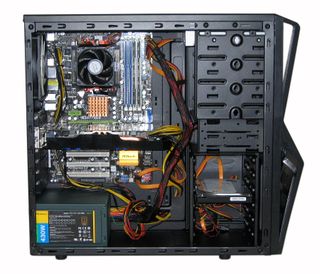System Builder Marathon, Sept. 2011: $500 Gaming PC
Assembly

We don't have any glaring caveats looming over this build, as it pretty much went off without a hitch. We’ve already used this motherboard on a few occasions, so discussion here focuses on the NZXT Gamma case.
Some builders may value the cooling and ventilation options provided by the Gamma. But, left unpopulated by fans, these vents could have adverse effects. The components inside were too visible and too audible for my liking, and the single rear exhaust fan is not suitable enough on its own considering the case's front, top, rear, and left side are peppered with vents and mesh. At the very least, a design this open warrants the inclusion of a front intake fan for aiding front-to-rear airflow, along with hard drive/motherboard cooling. By the time you start packing in extra cooling fans, some of the Rosewill or Antec offerings (which often include more bundled fans) might become more attractive.

We didn't have any problems with the sideways-mounted internal 3.5” drive cage, although it’s pretty tight with data and power cables attached. The motherboard tray does have holes for cable management, but the right panel fits too close to effectively route wires and hide spare power connectors.
Both steel side panels seemed flimsy and arrived warped, at times making their reattachment a chore. It's also hard to understand why the manufacturer chose to include an air filter mounted flush behind the angled front bezel, and then render it useless by including large bypass openings on the sides.
Lastly, as with any bottom-mounted power supply installation, a short eight-pin power lead for the CPU could introduce problems. Ours stretched from bottom to top, so long as we routed it under the graphics card. We didn't have much length to spare, though.

On a more positive note, this is a $36 case with the potential to move a large volume of air through its chassis. Prepping was a breeze; thumb screws and drive rails are included and work just as you'd expect them to. Also, an easy-to-remove front bezel helped simplify the optical drive's installation. This is a fairly roomy case, capable of accommodating graphics cards as long as 11 inches (though you'd have to scale that back a bit on boards with power connectors on the ends).
Stay on the Cutting Edge
Join the experts who read Tom's Hardware for the inside track on enthusiast PC tech news — and have for over 25 years. We'll send breaking news and in-depth reviews of CPUs, GPUs, AI, maker hardware and more straight to your inbox.
-
alchemy69 Time to bring on the usual motley crew of fanboys and everyone who just knows that they could do better.Reply -
Outlander_04 The i3 2100 is a remarkable cpu , but it just cant beat 4 physical cores and a bit of overclocking .Reply -
slicedtoad very nice article, i was wondering how the 955 oced would do against the i3.Reply
While there are many unthinkable things in this build, the low price of $500 is also unthinkable. That's less than an ipad.... -
zooted This is my favorite build this sbm. I just love the fact that you can have a true 1080p gaming experience for $500 bucks.Reply -
bobfrys This is a tad bit better then the one I built off of the earlier build i used from toms. (Built it soon after school ended).Reply -
lunyone This is probably the ONLY $500 build (except for the very 1st one) that I've agreed on mostly (not liking the case too much, but it works in this budget).Reply
The last $500 build just was crap generally (micro-ATX and not many options on the mobo, IMHO).
This budget gaming rig is really close to what I'd build for a friend/family member that wanted to have a gaming rig. I'd change a few things, of coarse, but the overall direction (and selection of parts) is SPOT ON, IMHO!! Good job guys at TH!!!
